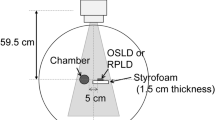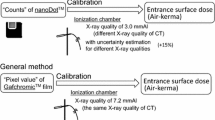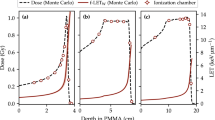Abstract
The use of Al2O3:C-based optically stimulated luminescent dosimeters (OSLDs) in diagnostic X-ray is a challenge because of their energy dependence (ED) and variability of element sensitivity factors (ESFs). This study aims to develop a method to determine ED and ESFs of Landauer nanoDot™ OSLDs for clinical X-ray and investigate the uncertainties associated with ESF and ED correction factors. An area of 2 × 2 cm2 at the central axis of the X-ray field was used to establish the ESFs. A total of 80 OSLDs were categorized into “controlled” (n = 40) and “less-controlled” groups (n = 40). The ESFs of the OSLDs were determined using an 80 kVp X-ray beam quality in free-air geometry. The OSLDs were cross-calibrated with an ion chamber to establish the average calibration coefficient and ESFs. The OSLDs were then irradiated at tube potentials ranging from 50 to 150 kVp to determine their ED. The uniformity of the X-ray field was ± 1.5% at 100 cm source-to-surface distance. The batch homogeneities of user-defined ESFs were 2.4% and 8.7% for controlled and less-controlled OSLDs, respectively. The ED of OSLDs ranged from 1.125 to 0.812 as tube potential increased from 50 kVp to 150 kVp. The total uncertainty of OSLDs, without ED correction, could be as high as 16%. After applying ESF and ED correction, the total uncertainties were reduced to 6.3% in controlled OLSDs and 11.6% in less-controlled ones. OSLDs corrected with user-defined ESF and ED can reduce the uncertainty of dose measurements in diagnostic X-rays, particularly in managing less-controlled OSLDs.








Similar content being viewed by others
References
Akselrod M, Bøtter-Jensen L, McKeever SWS (2006) Optically stimulated luminescence and its use in medical dosimetry. Radiat Meas 41:S78–S99
Yukihara EG et al (2008) Evaluation of Al2O3:C optically stimulated luminescence (OSL) dosimeters for passive dosimetry of high-energy photon and electron beams in radiotherapy. Med Phys 35(1):260–269
Yukihara EG, McKeever SWS (2008) Optically stimulated luminescence (OSL) dosimetry in medicine. Phys Med Biol 53(20):R351
Yukihara EG, Mckeever SWS (2011) Optically stimulated luminescence: fundamentals and applications Wiley, Hoboken
Lee SA et al (2020) The clinical utility of fluoroscopic versus CT guided percutaneous transpedicular core needle biopsy for spinal infections and tumours. A randomized trial. Spine J 7:1114–1124
Yusof FH et al (2015) On the use of optically stimulated luminescent dosimeter for surface dose measurement during radiotherapy. PLoS ONE 10(6):e0128544
Rejab M et al (2018) Dosimetric characterisation of the optically-stimulated luminescence dosimeter in cobalt-60 high dose rate brachytherapy system. Austr Phys Eng Sci Med 41:475–485
Wong JHD et al (2019) Eye lens dose of medical personnel involved in fluoroscopy and interventional procedures at a Malaysian hospital. Physica Med 68:47–51
Kry SF et al (2019) AAPM TG 191: clinical use of luminescent dosimeters: TLDs and OSLDs. Med Phys 47(2):e19–e51
Alves ADC et al (2015) Long term OSLD reader stability in the ACDS level one audit. Austr Phys Eng Sci Med 38(1):151–156
Dunn L et al (2013) Commissioning of optically stimulated luminescence dosimeters for use in radiotherapy. Radiat Meas 51:51–52
Jursinic PA (2007) Characterization of optically stimulated luminescent dosimeters, OSLDs, for clinical dosimetric measurements. Med Phys 34(12):4594–4604
Jursinic PA (2010) Changes in optically stimulated luminescent dosimeter (OSLD) dosimetric characteristics with accumulated dose. Med Phys 37(1):132–140
Jursinic PA, Yahnke CJ (2011) In vivo dosimetry with optically stimulated luminescent dosimeters, OSLDs, compared to diodes; the effects of buildup cap thickness and fabrication material. Med Phys 38(10):5432–5440
Abdullah N et al (2015) Assessment of surface dose on the art phantom using three dimensional conformal breast radiotherapy. Jurnal Sains Nuklear Malaysia 27(1):21–28
Ponmalar R et al (2017) Dosimetric characterization of optically stimulated luminescence dosimeter with therapeutic photon beams for use in clinical radiotherapy measurements. J Cancer Res Ther 13(2):304–312
Yukihara EG et al (2005) High-precision dosimetry for radiotherapy using the optically stimulated luminescence technique and thin Al2O3:C dosimeters. Phys Med Biol 50(23):5619
Al-Senan RM, Hatab MR (2011) Characteristics of an OSLD in the diagnostic energy range. Med Phys 38(7):4396–4405
Wong JHD et al (2019) Characterisation and evaluation of AL2O3:C-based optically stimulated luminescent dosemeter system for diagnostic x-rays: personal and in vivo dosimetry. Radiat Prot Dosimetry 187(4):451–460
Kerns JR et al (2011) Angular dependence of the nanoDot OSL dosimeter. Med Phys 38(7):3955–3962
Reft CS (2009) The energy dependence and dose response of a commercial optically stimulated luminescent detector for kilovoltage photon, megavoltage photon, and electron, proton, and carbon beams. Med Phys 36(5):1690–1699
Jursinic PA (2015) Angular dependence of dose sensitivity of nanoDot optically stimulated luminescent dosimeters in different radiation geometries. Med Phys 42(10):5633–5641
Zhuang AH, Olch AJ (2020) A practical method for the reuse of nanoDot OSLDs and predicting sensitivities up to at least 7000 cGy. Med Phys 47(4):1481–1488
Tariq M, Gomez C, Riegel AC (2019) Dosimetric impact of placement errors in optically stimulated luminescent in vivo dosimetry in radiotherapy. Phys Imaging Radiat Oncol 11:63–68
NIST Physical Reference Data. (2009) http://physics.nist.gov/PhysRefData/contents.html Accessed 13 Jan 2009
Jursinic PA (2020) Optically stimulated luminescent dosimeters stable response to dose after repeated bleaching. Med Phys 47(7):3191–3203
Nakatake C, Araki F (2021) Energy response of radiophotoluminescent glass dosimeter for diagnostic kilovoltage x-ray beams. Physica Med 82:144–149
Acknowledgements
We thank all staff members at the Malaysian Nuclear Agency, especially those at the medical physics and personal dosimeter laboratories, for their assistance. We thank Ahmad Bazlie Abdul Kadir for providing the OSLDs and allowing the use of his laboratory facilities.
Funding
This project was partially funded by the Universiti Malaya Matching Grant, MG: Development And Validation Of Advance Radiation Dosimetry Tool For Quality And Dosimetry Of Digital Imaging (MG008-2022).
Author information
Authors and Affiliations
Contributions
All authors contributed to the study design, measurements, data analysis, manuscript drafting, editing and finalising. All authors read and approved the final manuscript.
Corresponding author
Ethics declarations
Conflict of interest
The authors have no relevant financial or non-financial interests to disclose.
Additional information
Publisher’s Note
Springer Nature remains neutral with regard to jurisdictional claims in published maps and institutional affiliations.
Rights and permissions
Springer Nature or its licensor (e.g. a society or other partner) holds exclusive rights to this article under a publishing agreement with the author(s) or other rightsholder(s); author self-archiving of the accepted manuscript version of this article is solely governed by the terms of such publishing agreement and applicable law.
About this article
Cite this article
Wong, J.H.D., Ismail, W.H. Addressing challenges in diagnostic X-ray dosimetry: uncertainties and corrections for Al2O3:C-based optically stimulated luminescent dosimeters. Phys Eng Sci Med (2024). https://doi.org/10.1007/s13246-024-01407-y
Received:
Accepted:
Published:
DOI: https://doi.org/10.1007/s13246-024-01407-y




